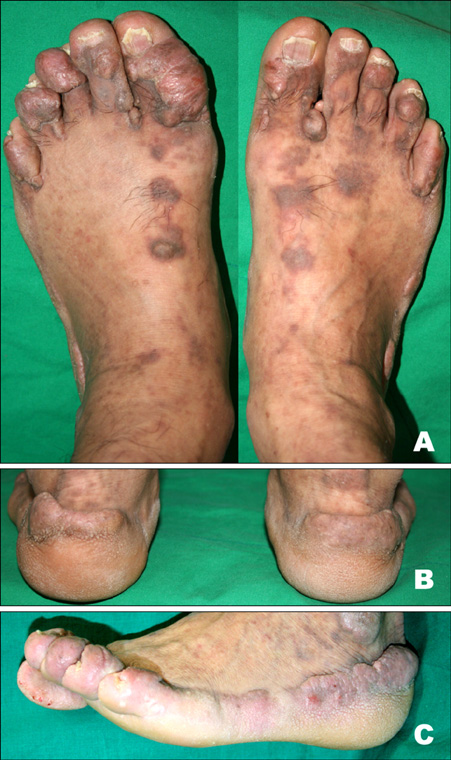Ann Dermatol.
2009 Aug;21(3):326-329. 10.5021/ad.2009.21.3.326.
A Case of Elephantiasis Nostras Verrucosa
- Affiliations
-
- 1Department of Dermatology, School of Medicine, Kyunghee University, Seoul, Korea. crhaw@khmc.or.kr
- KMID: 2266304
- DOI: http://doi.org/10.5021/ad.2009.21.3.326
Abstract
- Elephantiasis nostras verrucosa (ENV) is a rare clinical condition associated with chronic non-filarial lymphedema caused by bacterial or non-infectious lymphatic obstruction. A variety of etiologies, including infection, tumor obstruction, trauma, radiation, chronic venous stasis, congestive heart failure, and obesity, can lead to chronic lymphatic obstruction and edema. Mossy papules, plaques, and cobblestone-like nodules are clinically impressive features of ENV, but biopsy reveals only moderately abnormal findings such as pseudoepitheliomatous hyperplasia, dilated lymphatic spaces, fibrous tissue hyperplasia, and chronic inflammation. We present a case of ENV in a 67-year-old man with a 10-year history of multiple nodules and verrucous plaques on both feet. Microbiology ruled out a filarial infection. Nodule biopsy revealed pseudoepitheliomatous hyperplasia, marked dermal fibrosis, and a chronic inflammatory infiltrate. No evidence of carcinoma was identified. Both venous stasis and recurrent cellulitis could contribute to the dermal fibrotic changes of the lesions. However, before the recurrent cellulitis, he did not have any nodular lesions on his feet despite a 10-year history of venous disease. Therefore, this case suggests that venous stasis alone cannot produce the fibrotic nodular lesions of ENV
MeSH Terms
Figure
Reference
-
1. Castellani A. Researches on elephantiasis nostras and elephantiasis tropica with special regard to their initial stage of recurring lymphangitis (lymphangitis recurrens elephantogenica). J Trop Med Hyg. 1969. 72:89–97.2. Sisto K, Khachemoune A. Elephantiasis nostras verrucosa: a review. Am J Clin Dermatol. 2008. 9:141–146.3. Routh HB. Elephantiasis. Int J Dermatol. 1992. 31:845–852.4. Schissel DJ, Hivnor C, Elston DM. Elephantiasis nostras verrucosa. Cutis. 1998. 62:77–80.5. Choi JM, Park CJ, Yi JY. A case of elephantiasis nostras. Korean J Dermatol. 1998. 36:1098–1100.6. Castellani A. Elephantiasis nostras. J Trop Med Hyg. 1934. 37:257–264.
Article7. Duckworth AL, Husain J, Deheer P. Elephantiasis nostras verrucosa or "mossy foot lesions" in lymphedema praecox: report of a case. J Am Podiatr Med Assoc. 2008. 98:66–69.
Article8. Turhan E, Ege A, Keser S, Bayar A. Elephantiasis nostras verrucosa complicated with chronic tibial osteomyelitis. Arch Orthop Trauma Surg. 2008. 128:1183–1186.
Article9. Boyd J, Sloan S, Meffert J. Elephantiasis nostrum verrucosa of the abdomen: clinical results with tazarotene. J Drugs Dermatol. 2004. 3:446–448.10. Bergan JJ, Schmid-Schonbein GW, Smith PD, Nicolaides AN, Boisseau MR, Eklof B. Chronic venous disease. N Engl J Med. 2006. 355:488–498.
Article11. Chernosky ME, Derbes VJ. Elephantiasis nostras of the abdominal wall. Arch Dermatol. 1966. 94:757–762.
Article12. Barron GS, Jacob SE, Kirsner RS. Dermatologic complications of chronic venous disease: medical management and beyond. Ann Vasc Surg. 2007. 21:652–662.
Article13. Kakati S, Doley B, Pal S, Deka UJ. Elephantiasis Nostras Verrucosa: a rare thyroid dermopathy in Graves' disease. J Assoc Physicians India. 2005. 53:571–572.14. Zouboulis CC, Biczo S, Gollnick H, Reupke HJ, Rinck G, Szabo M, et al. Elephantiasis nostras verrucosa: beneficial effect of oral etretinate therapy. Br J Dermatol. 1992. 127:411–416.
Article15. Iwao F, Sato-Matsumura KC, Sawamura D, Shimizu H. Elephantiasis nostras verrucosa successfully treated by surgical debridement. Dermatol Surg. 2004. 30:939–941.
Article
- Full Text Links
- Actions
-
Cited
- CITED
-
- Close
- Share
- Similar articles
-
- A Case of Elephantiasis Nostras Verrucosa Caused by Recurrent Infection after Skin Grafting
- A Case of Elephantiasis Nostras Verrucosa Treated with Oral Acitretin
- A Case of Elephantiasis Nostras
- Two Cases of neurofibromatosis showing Elephantiasis Neurofibromatosa in A Family
- Tuberculosis Verrucosa Cutis in a Patient with Pulmonary Tuberculosis



